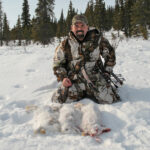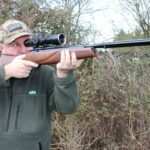If you’ve made the mistake of leaving your trail cameras hanging on the same tree from opening day until post-rut then it’s time to start looking at the calendar and designing a better trail camera strategy for different seasons.
Please note this trail camera placement strategy guide does not give exact dates due to our global customer base and that every region is a little different. Shoot, even Northern and Southern deer hunters in the States will have different time schedules when they move trail cams, but you get the point!
Table of Contents
Early Spring Trail Camera Strategies
Even if you like to track spring gobblers during this time of year (and who doesn’t), you can still kick off your trail camera tour. The only thing needed is a little attractant to get the ball rolling. For the most part, this includes one ingredient – salt.
Not only are minerals a good attractant, but introducing an intruder into the area is a great way to arouse a buck’s interest. This can be accomplished with a licking branch and some natural, pre-orbital gland secretions.
As soon as the leaves start to gobble up, the landscape buck antlers will start growing, and they will naturally seek out salt and other minerals. Whitetail does and fawns will also be attracted to these sites, and capturing them on camera is a great way to determine how many new deer have been added to the herd as well as how many does are in the area. This info will be precious in a few short months when the rut kicks in.
Doe bedding areas or suspected big buck hideouts are great locations to start mineral sites in early spring. Look for pinch points and funnels that will drive deer to your salt block and, ultimately, your trail camera. If you live in agricultural areas, then field edges are a great place to start. Once travel routes have been revealed, you can always choose to delve deeper into cover and start a new mineral site to get closer to bedding or staging areas.
Summer Trail Camera Strategies
By now, your food plot should be in full swing. If so, a trail camera set up along the fringes would be a great way to capture that nocturnal buck who only hits the fields at night. In areas where baiting is legal, trail cameras could be set up over bait to get the same results.
Either way, food will be the primary driving force for deer movement, so it only makes sense to hang your trail camera in areas where deer will be feeding. Summer is also a good time to consider staking out a water source with your trail camera to help deer movement. Don’t dismiss the value of a central hub of H2O in your hunting area. Hang that trail camera.
On a side note, this is also a great time to conduct a trail camera survey if you have a private tract of land you will be hunting on. It’s hands-down the best way to monitor your deer herd population. You’ll be able to estimate your deer density, fawn recruitment, sex ratio, the age structure of your bucks, and more.
Early Fall Trail Camera Strategies
As I eluded to earlier, things change. Those locations that proved so good in early and late summer are now proving to be different. This is simply due to changes in food and cover. Leaves are turning and falling, and deer are ready to find alternate food sources – like acorns!
In addition, testosterone is gradually starting to build in male deer. This causes a variety of behavioral changes, which will ultimately change deer movement and sightings. To keep up with these changes, you must move your trail cameras.
Food sources can change throughout the course of a season, so become familiar with all types, especially those that appear naturally in your hunting area.
Food can still be a hot ticket, but bedding areas, travel routes, and staging areas are usually where you will find a lot of buck movement. Some of the images you capture will be in daylight but expect many of them to occur under cover of darkness. That’s just the nature of the beast when you’re dealing with mature bucks.
Nevertheless, you can’t formulate a plan of attack until you get confirmation a big buck is in the area – day or night. So start by capturing the image first, then move on.
Pre Rut/Rut Trail Camera Strategies
Things get hectic during this time frame as bucks move with reckless abandonment, looking for a hot doe. In the weeks leading up to the actual breeding phase, bucks will leave a bevy of signs announcing their aggression and intentions. Look for that sign and consider hanging your favorite trail camera somewhere nearby.
Once the actual breeding begins, you can expect a drop in mature buck movement as they are pushing does into more secluded areas to not only avoid the pressure from other bucks but the onslaught of hunting pressure as well. Your trail cameras and treestands should be moved as well.
I like pinch points, oak flats, logging roads, secluded ridge top saddles, field edges, and the fringes of doe bedding areas or anywhere else the females congregate. A camera hung somewhere along my entry, and the exit route means I can check it on days that I hunt without disturbing the bucks I am chasing before the hunt. This also allows me to decide if the area I am hunting is worth returning to or if I should pull up the stakes and move on.
Post Rut/Winter Trail Camera Strategies
Everything old is new again as the urge to breed is over, and the focus once again shifts to food. And while you may want to keep a few cameras hanging over remaining food sources, it wouldn’t hurt to keep one in the areas you used during the rut. There is always the chance that the buck you’re after hasn’t given up hope and is still searching for love. Only your trail camera will tell you if that is the case or not.
In addition, this is a great time to conduct an end-of-the-season or winter trail camera survey. With deer searching for food, you’ll be able to get a tally of the bucks that made it through the year, as well as an understanding of your property’s deer density, buck to doe ratio, age structure, and more. Just like the trail camera survey you should run in late summer, this information is critical to understanding how you should approach the upcoming season.
Conclusion
Deer movement is one of the most important keys to getting the most out of your trail camera. Adjust your trail camera strategies to match each phase of the whitetail season, and you will gain a plethora of knowledge that will ultimately lead to more filled tags. The trick is finding a way to manage all of that trail camera knowledge and data. Once that happens, all of the puzzle pieces will start to fall into place—best of luck.
PS – If you’re using trail cameras and haven’t tried DeerLab’s trail camera photo management service, we invite you to sign-up for our free 30-day trial. We think it will completely change the way you view trail camera photos.











































